 Facebook
Facebook
 X
X
 Instagram
Instagram
 TikTok
TikTok
 Youtube
Youtube
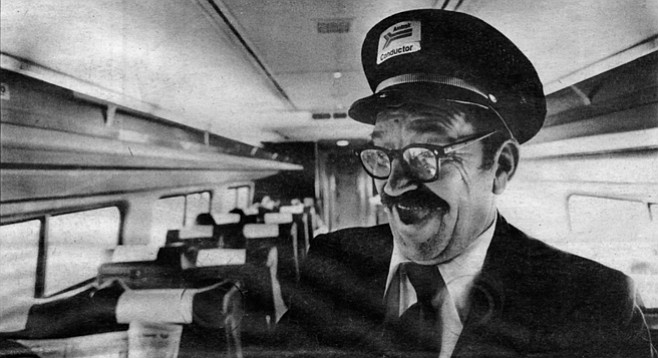
Amtrak insists this is not a commuter train. “A commuter train run is not 128 miles in length,” the Amtrak spokesman in San Francisco says with an edge to his voice. You can almost see him pursing his lips and tightening his grip on his pencil. Indeed, when the first "San Diegan” pulls out of the Santa Fe Depot downtown at 5:15 every morning, the ambiance supports his words. The station lobby is too vast, too elegant; dim light cloaks the huge machine trembling at the platform. Transcontinental journeys ought to begin here, not trips to work. But San Diego County residents will board this train today and ride it to their jobs. One by one they are turning to this hungry metal monster and feeding it four hours daily from their lives. The most amazing thing about them is that they’re absolutely delighted with themselves.
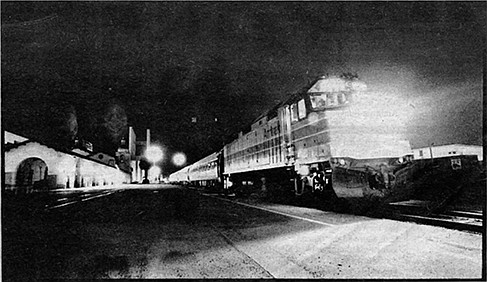
Few of them board the train at the downtown station, at this hour so silent you can walk down the middle of Kettner Boulevard in front of the depot and hear yourself breathing; the crowds get on a little further down the line. Ken Mobley sells tickets here and he still only recognizes four or five regular faces. Today, in fact, only two of the thirteen passengers pulling out of the station are daily commuters. and Jerry Gunnels confesses that he only started making the commute three weeks ago. By the time the train starts to pick up speed and chugs past Pacific Beach, Gunnels has settled back comfortably with his morning Union. However, he breaks away eagerly to talk about his choice of transportation. ”I love it,” he declares simply. “I plan to do it this way as long as possible.”
Thirty four-year-old Gunnels used to live and work in San Diego, but then three years ago his company, Safeco Title Insurance, transferred him to the Santa Ana office. Gunnels moved his family to Orange County but his wife got sick and wasn’t happy living there, so they moved back. Now they live in Santee. Born and bred in California, Gunnels admits he had to fight a long-held misconception about trains. "I kept imagining the subways in New York City and thinking it would be like that.” Then he traveled on this line, which Amtrak acquired from Santa Fe eight years ago.
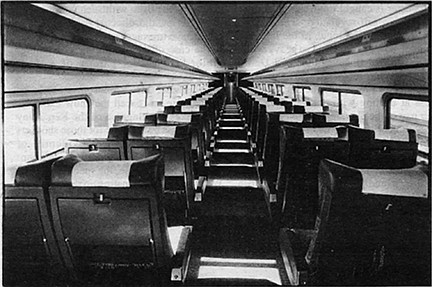
The car in which he now sits resembles the interior of an airplane cabin more than it does the IRT. Carpeting covers the floors and climbs part way up the walls, and the purple-print upholstery that brightens the seats looks lived in but clean. Only one other passenger, a young attorney on her way to a day in Los Angeles municipal court, shares the car with him. Gunnels can read his newspaper under the glowing seat light in gently rocking peace. He says he happily rises at four every morning. His wife drives him into San Diego; he gets to Santa Ana by 6:55, then walks nine blocks to his office. There’s no return train from Santa Ana to San Diego between 2:21 p.m. and the 5:21 p.m., so Gunnels instead rides home on the Greyhound bus.
In the next car, Ray Sarbacker also plans to disembark at Santa Ana, but normally he takes the train leaving San Diego at 7:00 a.m. This morning he caught the earlier run in order to make a special meeting at his Newport Beach ad agency. Sarbacker looks like an advertising executive. His cream-colored leisure suit complements his tan, and he draws deeply on a cigarette between sentences. He says he used to live in Newport Beach, then last September his wife got an excellent job here, so the two of them moved to Mission Bay, where they now live on a boat. He drove for a few months, a commute that took between an hour and a half and an hour and forty-five minutes to get from door to door. Now the train ride eats up an hour and forty minutes, after which Sarbacker must drive to Newport Beach (he leaves his car at the Santa Ana station). So the whole trip takes him at least an hour and fifty minutes. Yet he declares, “I figured that when you add up the gas and insurance and oil and everything, it ends up costing about the same. The difference is that I get three hours more every day!”
Sarbacker normally returns on one of the evening trains (from Santa Ana he can take the 5:21, the 6:21, or even the 9:21 on late nights), and the daily round-trip fare costs him $10.50, less than the cost of two one-way tickets for the San Diego-Santa Ana run. However, he still complains about the absence of any true commuter fare offering discounts that would specifically encourage daily passengers. (This fare, in contrast, applies to any occasional round-trip rider.) “I think you’ll find that a lot of the regular riders aren’t too happy about that,” Sarbacker says.
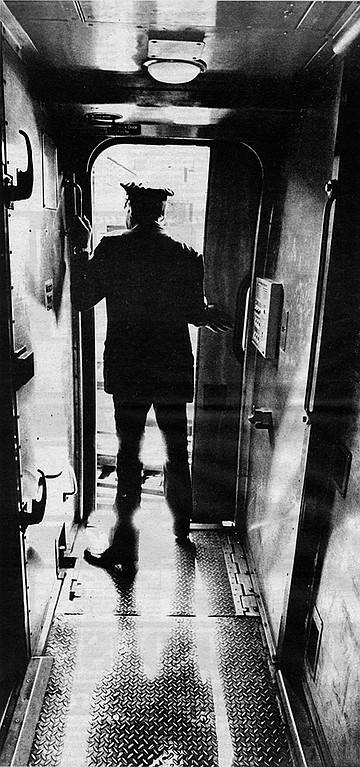
Art Lloyd, Amtrak’s San Francisco spokesman, points out that Amtrak for a long time was not legally permitted to run any commuter services, but finally a new law changed that last October, allowing the train authority to sell San Diego-Los Angeles passengers weekly or monthly passes. Lloyd, though, says the law also requires Amtrak to be fully reimbursed for any commuter lines; if fares don’t cover all expenses, local authorities (such as Caltrans or the county governments) must pick up the difference. At the moment, Caltrans money does partially support three of the trains on this run, with the state paying for fifty percent of the operating losses on two of them, but Amtrak kicks in the heftiest financial contribution for this train service. For its 1978 fiscal year, Amtrak’s fully allocated cost for the service was $13,732,000, but the route only generated revenues of $4,291,000. Even after subtracting the state and local contributions, Amtrak’s net cost for that year was $7,932,000. Lloyd carps that that figure includes the Los Angeles-San Diego run’s share of every expense within the Amtrak system — all the overhead, all the salaries of the Washington bureaucrats, everything — and that the actual operating expenses for the line are much lower. In any case, he states emphatically that Amtrak doesn’t intend to give daily riders discounts that would lower their contributions. “We’re not eager to dilute the revenues any further. We’re already in a losing position,” he says. Besides, he reiterates testily, Amtrak feels that this line is just too long to be considered a commuter line. “The trains are not scheduled to serve commuters.”
5:47 a.m. — When the train pulls into Del Mar, slate-colored cloud fragments float above an ocean already touched by morning’s glow. Fifteen men cluster on the platform; their faces still look pressed with sleep. They wear a uniform of gray suits, striped ties, and briefcases that makes them indistinguishable from their brothers waiting on train platforms in the East. “Are you people waiting for a train?” the conductor bellows cheerfully as the cars lurch to a halt. The men banter with him easily as they file aboard.
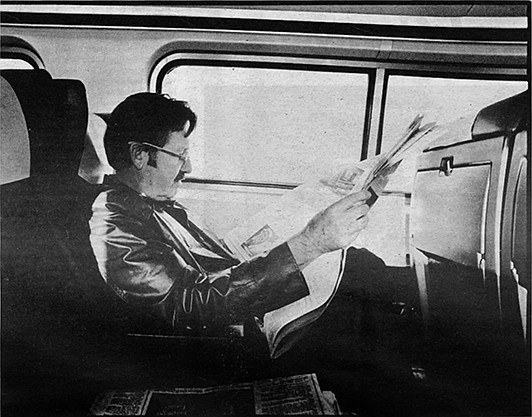
One who defies the pinstripe image owns a window factory in suburban Montclair. Arthur Graves wears a sweater vest under a brown leather jacket, and his affable face beams over a gold chain around his neck. The train station is just minutes away from his Sea Point home in Del Mar, but at the other end of his journey, in Fullerton, he has to climb into his parked car and drive for another half hour. His total commute time thus spans from about 5:45 a.m. to about 7:45. Why doesn’t he live closer to his office? “Have you ever been to Monclair?" he responds. Before moving to Del Mar, he lived in Corona Del Mar, but that required an hour-long commute, which was even more stressful because of the extra traffic. “Now I can get a lot of work done on the train,” he adds. “I enjoy this time. I get a chance to think.” Graves says he’s watched the number of his fellow passengers swell over the past two years. “We see a lot of familiar faces now.”
A short, effervescent conductor interrupts , Graves’s comments. “Shaaakeytown, Shaaakeytown!” he cries as he moves up the aisles and punches tickets. In the snack car, he leans against the counter and jokes with passengers buying their daily coffee and sweet rolls. “We see the same people practically every day,” H. B. Williams' says with satisfaction. “When this train started [February 14 last year], we were pulling into L.A. with only about fifty people. Now we’re up to 150 to 200 every day." Lloyd, the Amtrak spokesman, says the growth on this earliest morning train has followed a pattern throughout the line. Three daily round-trip trains were carrying about 300,000 passengers a year in 1975. Amtrak added all new equipment and a fourth round-trip in 1976; a fifth came in 1977, and by the end of that year volume reached 689,000 passengers. It grew to 793,900 passengers in 1978 (when the sixth round-trip was added), and Lloyd says Amtrak expects it will approach a million by the end of this year.
6:04 a.m. — Morning has now reached a full bright blue, and Williams greets about twenty-seven people at the Oceanside station. Back in the snack car, rolling again, he tells proud stories about the regular passengers. “We have enough lawyers get on this train every morning and every night to hold a meeting of the bar association.” he boasts. “We have two vice-presidents for Security Pacific Bank.” Several passengers work in the clothing industry; three or four have Los Angeles travel bureaus; and Williams says one is a major tennis shoe distributor. "We even have one guy who owns a truck stop in Vernon. He commutes every day from San Juan,” Williams chortles happily. “They call him the cowboy!”
The conductor leads the way to Mike Sansky, a neatly dressed, middle-aged man who works in administration for the Los Angeles Police Department. Sansky says he moved to San Diego County because he knew he could ride the train to work; he can think of about a half dozen L.A. cops who do so. Then Sansky turns around and introduces Paul Morris and Eleanor Segard, two other veterans of the rails. Morris is a worn, balding man whose coat shines ever so slightly with age. This morning his smile is as relaxed as that of a person on vacation. He still sells textiles in the Los Angeles Merchandise Mart, but he escaped from North Hollywood to Fallbrook a couple of years ago. Now he drives to Oceanside every morning to catch the train at 6:04 and arrives in downtown Los Angeles by 7:50. Segard, Morris’s seatmate, picks up her parked car at Union Station and gives Morris a lift to his job, then she proceeds to her own job, where she works as an accountant for the wealthy Mudd family. Segard moved from Long Beach to Vista seven years ago and says she tried maintaining an apartment in Los Angeles for two and half years, living in the city during the week and going home on the weekends. “But that wasn’t any way to live,” she says gloomily. She nods her head decisively when Morris exclaims, “The train isn’t bad at all. It’s delightful! The air is crystal clear. There’s no traffic. What more could you ask for?” Outside the window, the hills of Camp Pendleton roll by in a bright, green panorama. In the distance, surfers bob in the waves in the morning light.
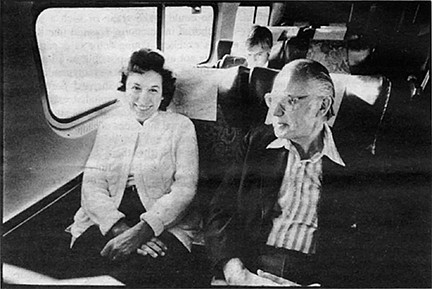
Morris and Segard were among about sixty riders who turned out for a Christmas party this past December (the second annual one) held in the home of a Del Mar regular. Williams, the loquacious conductor, says these cars see their share of celebrations. “It was my own birthday last week and we had a little party for that,” he says happily. Many of the passengers who take this earliest train also return together from Los Angeles on the 4:30 p.m. train (it arrives back in San Diego at 7:05 p.m.). Further heightening the family feeling is the fact that the earliest morning crew also returns to San Diego on the 4:30 train. Similarly, the 7:00 a.m. crew returns on the 8:30 one. and the crew that leaves San Diego at 9:30 a.m. returns on the 5:30 train at night.
A bizarre union requirement knits the crew together even more tightly than the regular passengers, if possible. The union regulations say that crew members must be "home-based” out of the railroad “terminals,” but Los Angeles is the terminal in this case, and not San Diego. So even though the first three trains set out each day from San Diego, and the crews which serve them return to San Diego on the last three trains, crew members like Williams all have their homes around Los Angeles. That means Amtrak pays to put the men up in hotels twenty nights a month. Williams says fifteen of them — five crew members from three trains a day — stay in the Imperial 400 motel, next to the Jack-in-the-Box on Pacific Highway. Those who serve the earliest train don’t seem to mind the peculiar arrangement; they could in fact move to San Diego if they wanted to. Williams, for example, catches a bite to eat after the train pulls in at 7:05, then goes to bed early in order to rise before dawn. “It isn’t bad,” he shrugs. “We have our same rooms all the time, so we can keep our stuff there. . . . And after you’ve been married for thirty-four years, who cares?” he guffaws, eyes twinkling. When the morning train he works on pulls into L.A. at 7:50, Williams drives to his home in San Dimas and the other crew members disperse for homes in Anaheim and San Bernardino. Ted Klix, the head brakeman, says he’s delighted to tend to chores in the middle of the day, when crowds are lightest. If the arrangement is an expensive one. Lloyd, the Amtrak spokesman, retorts, “That’s just the way the union set-up is. We inherited it." Histone is exasperated. He says a different schedule might be more logical, “and I’m sure it would be very nice, but unfortunately, we don’t live that way with the union.”
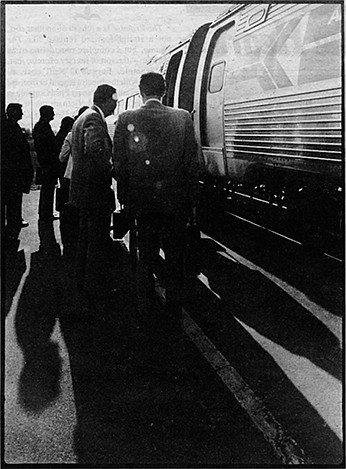
6:33 a.m. — Forty-eight people crowd up to the rails on the platform in San Juan Capistrano, even though today is a Friday and the crews say Fridays and Mondays draw the lightest loads. Most of these people, like one red-faced man whose destination is a juice-packing business he owns in East Los Angeles, have risen a full hour later than those who started this ride in San Diego. The businessman fled Los Angeles and moved to San Clemente ten years ago. He explains, “I drove for seven years and by the end of that time I was ready to expire. The thing was, when I started out ten years ago my drive time was consistently an hour to an hour and fifteen minutes, and that wasn’t too bad. But by the time I stopped three years ago, it might take me up to two hours to get there!” The uncertainty tormented him. “So you’d end up having to leave two hours ahead of time to be sure that you’d make it on time to an appointment. And of course that would be the one day you’d make it in an hour.” Three years ago it dawned on him that he could take the train instead. At that time the earliest train came at 8:18, so he couldn’t reach his office until ten each morning, and he had to leave by four to catch the evening train home. “It’s tough having such a short day like that,” he says. “You can’t accomplish as much as you want to.” But it was worth it, just as it’s worth it now for him to maintain two cars — one which he drives from San Clemente to San Juan Capistrano every morning, and one which he parks at Union Station and uses for the ten-minute final leg to his East Los Angeles plant. His daily journey takes almost two hours each way, and he pays twenty dollars a month in parking. Yet three years removed from the daily drive, he still looks like a man newly released from prison.
6:15 a m. — Thirty-eight new riders climb onto the train at Santa Ana, and some of the earliest riders, such as Sarbacker and Gunnels, depart. Twenty minutes later the largest group of the day, seventy-five passengers, clambers aboard at Fullerton, the last stop before the end of the line. Exactly two hours ago the train left San Diego, and somehow this final group seems like a pack of intruders as they scatter throughout the four cars for the thirty-five-minute ride to Union Station.
Brown filth has begun to color the air outside by 7:30, even though clouds from a recent rain cover the sky like a tattered blanket. Dreary battalions of tract homes march by the train windows regularly, and soon they yield to the sprawl of Southern California's industry. Pollution has appeared inside the cars to match the external ugliness. Smoke hangs heavily in the club car, where a loud, early-morning card game has swung into action. Thick chatter has sprung up to choke off the subtle noises of the rails. Yet even on this final leg, dozens of seats remain empty.
One group of train buddies dressed in suits and ties clusters together in the last car, giving it the look of some strange mobile office. Each man has staked out two seats and spread his papers over them; they sip coffee and periodically crack jokes. When asked about the train service, they could pass for actors in an Amtrak commercial.
Love it! they chorus while flashing triumphant grins. They look like people who’ve stumbled, by chance, on a wonderful secret.
“Let’s face it, when you ride that morning flight on PSA, it is a cattle car,” declares one prematurely white-haired banker. “But this,” he waves expansively. “This is just like riding first-class on an airplane.” He explains that he and many members of the Los Angeles business community follow the same routine when they arrive at Union Station. They wait, usually no more than ten minutes, for the transit-district sponsored “mini-bus” that stops in front of the station, costs fifteen cents a ride, and loops around the financial district from Occidental Tower down to Chinatown. Before moving to San Clemente, the banker and his family lived in Downey. “We moved specifically because of the train,” he says proudly. “We went down and bought our house the weekend after we heard the plans for it announced. It was our chance to improve our standard of living and get out of that bedroom community. We figured that even if the trial train didn't work we'd still be ahead. We'd have had the best summer of our lives.”
Someone mentions Japanese commuters, who've long endured grueling train journeys through the Tokyo megalopolis. Trains there are jammed with sleepy riders who stand for two hours or more, and houses near the farthest terminals command a premium from seat-seekers. But these men shrug off that nightmarish vision in spite of the fact that the number of Amtrak’s early riders is climbing daily and that Orange County developers now are mentioning the train in their ads. Today, however, the scenes rushing past their windows still are filled with open, undeveloped land. The air is clean; the tax-payers kick in two dollars for each one the riders pay. These men figure tomorrow Amtrak can always add more cars.
Across from the prematurely white-haired banker sits another rider, prematurely bald. He lives on an avocado farm in Highland Valley, between Escondido and Ramona, and he commutes to a job in the food industry in Los Angeles. If he were a cat, he’d be purring now. He says earlier he'd looked out at the waves breaking in the crystalline light of dawn, and it seemed like nothing had changed, not since the days when he rode the train down here from Pasadena in search of exceptional surf. He says his favorite section of the long ride is the stretch through Camp Pendleton. "I take my cup of coffee and I just sit and look. That’s my special time of day.” As he talks, he pays no attention to the blur of houses jammed together outside his window, and he’s grinning from ear to ear. He can’t even see the freeway from here.


Amtrak insists this is not a commuter train. “A commuter train run is not 128 miles in length,” the Amtrak spokesman in San Francisco says with an edge to his voice. You can almost see him pursing his lips and tightening his grip on his pencil. Indeed, when the first "San Diegan” pulls out of the Santa Fe Depot downtown at 5:15 every morning, the ambiance supports his words. The station lobby is too vast, too elegant; dim light cloaks the huge machine trembling at the platform. Transcontinental journeys ought to begin here, not trips to work. But San Diego County residents will board this train today and ride it to their jobs. One by one they are turning to this hungry metal monster and feeding it four hours daily from their lives. The most amazing thing about them is that they’re absolutely delighted with themselves.

Few of them board the train at the downtown station, at this hour so silent you can walk down the middle of Kettner Boulevard in front of the depot and hear yourself breathing; the crowds get on a little further down the line. Ken Mobley sells tickets here and he still only recognizes four or five regular faces. Today, in fact, only two of the thirteen passengers pulling out of the station are daily commuters. and Jerry Gunnels confesses that he only started making the commute three weeks ago. By the time the train starts to pick up speed and chugs past Pacific Beach, Gunnels has settled back comfortably with his morning Union. However, he breaks away eagerly to talk about his choice of transportation. ”I love it,” he declares simply. “I plan to do it this way as long as possible.”
Thirty four-year-old Gunnels used to live and work in San Diego, but then three years ago his company, Safeco Title Insurance, transferred him to the Santa Ana office. Gunnels moved his family to Orange County but his wife got sick and wasn’t happy living there, so they moved back. Now they live in Santee. Born and bred in California, Gunnels admits he had to fight a long-held misconception about trains. "I kept imagining the subways in New York City and thinking it would be like that.” Then he traveled on this line, which Amtrak acquired from Santa Fe eight years ago.

The car in which he now sits resembles the interior of an airplane cabin more than it does the IRT. Carpeting covers the floors and climbs part way up the walls, and the purple-print upholstery that brightens the seats looks lived in but clean. Only one other passenger, a young attorney on her way to a day in Los Angeles municipal court, shares the car with him. Gunnels can read his newspaper under the glowing seat light in gently rocking peace. He says he happily rises at four every morning. His wife drives him into San Diego; he gets to Santa Ana by 6:55, then walks nine blocks to his office. There’s no return train from Santa Ana to San Diego between 2:21 p.m. and the 5:21 p.m., so Gunnels instead rides home on the Greyhound bus.
In the next car, Ray Sarbacker also plans to disembark at Santa Ana, but normally he takes the train leaving San Diego at 7:00 a.m. This morning he caught the earlier run in order to make a special meeting at his Newport Beach ad agency. Sarbacker looks like an advertising executive. His cream-colored leisure suit complements his tan, and he draws deeply on a cigarette between sentences. He says he used to live in Newport Beach, then last September his wife got an excellent job here, so the two of them moved to Mission Bay, where they now live on a boat. He drove for a few months, a commute that took between an hour and a half and an hour and forty-five minutes to get from door to door. Now the train ride eats up an hour and forty minutes, after which Sarbacker must drive to Newport Beach (he leaves his car at the Santa Ana station). So the whole trip takes him at least an hour and fifty minutes. Yet he declares, “I figured that when you add up the gas and insurance and oil and everything, it ends up costing about the same. The difference is that I get three hours more every day!”
Sarbacker normally returns on one of the evening trains (from Santa Ana he can take the 5:21, the 6:21, or even the 9:21 on late nights), and the daily round-trip fare costs him $10.50, less than the cost of two one-way tickets for the San Diego-Santa Ana run. However, he still complains about the absence of any true commuter fare offering discounts that would specifically encourage daily passengers. (This fare, in contrast, applies to any occasional round-trip rider.) “I think you’ll find that a lot of the regular riders aren’t too happy about that,” Sarbacker says.

Art Lloyd, Amtrak’s San Francisco spokesman, points out that Amtrak for a long time was not legally permitted to run any commuter services, but finally a new law changed that last October, allowing the train authority to sell San Diego-Los Angeles passengers weekly or monthly passes. Lloyd, though, says the law also requires Amtrak to be fully reimbursed for any commuter lines; if fares don’t cover all expenses, local authorities (such as Caltrans or the county governments) must pick up the difference. At the moment, Caltrans money does partially support three of the trains on this run, with the state paying for fifty percent of the operating losses on two of them, but Amtrak kicks in the heftiest financial contribution for this train service. For its 1978 fiscal year, Amtrak’s fully allocated cost for the service was $13,732,000, but the route only generated revenues of $4,291,000. Even after subtracting the state and local contributions, Amtrak’s net cost for that year was $7,932,000. Lloyd carps that that figure includes the Los Angeles-San Diego run’s share of every expense within the Amtrak system — all the overhead, all the salaries of the Washington bureaucrats, everything — and that the actual operating expenses for the line are much lower. In any case, he states emphatically that Amtrak doesn’t intend to give daily riders discounts that would lower their contributions. “We’re not eager to dilute the revenues any further. We’re already in a losing position,” he says. Besides, he reiterates testily, Amtrak feels that this line is just too long to be considered a commuter line. “The trains are not scheduled to serve commuters.”
5:47 a.m. — When the train pulls into Del Mar, slate-colored cloud fragments float above an ocean already touched by morning’s glow. Fifteen men cluster on the platform; their faces still look pressed with sleep. They wear a uniform of gray suits, striped ties, and briefcases that makes them indistinguishable from their brothers waiting on train platforms in the East. “Are you people waiting for a train?” the conductor bellows cheerfully as the cars lurch to a halt. The men banter with him easily as they file aboard.

One who defies the pinstripe image owns a window factory in suburban Montclair. Arthur Graves wears a sweater vest under a brown leather jacket, and his affable face beams over a gold chain around his neck. The train station is just minutes away from his Sea Point home in Del Mar, but at the other end of his journey, in Fullerton, he has to climb into his parked car and drive for another half hour. His total commute time thus spans from about 5:45 a.m. to about 7:45. Why doesn’t he live closer to his office? “Have you ever been to Monclair?" he responds. Before moving to Del Mar, he lived in Corona Del Mar, but that required an hour-long commute, which was even more stressful because of the extra traffic. “Now I can get a lot of work done on the train,” he adds. “I enjoy this time. I get a chance to think.” Graves says he’s watched the number of his fellow passengers swell over the past two years. “We see a lot of familiar faces now.”
A short, effervescent conductor interrupts , Graves’s comments. “Shaaakeytown, Shaaakeytown!” he cries as he moves up the aisles and punches tickets. In the snack car, he leans against the counter and jokes with passengers buying their daily coffee and sweet rolls. “We see the same people practically every day,” H. B. Williams' says with satisfaction. “When this train started [February 14 last year], we were pulling into L.A. with only about fifty people. Now we’re up to 150 to 200 every day." Lloyd, the Amtrak spokesman, says the growth on this earliest morning train has followed a pattern throughout the line. Three daily round-trip trains were carrying about 300,000 passengers a year in 1975. Amtrak added all new equipment and a fourth round-trip in 1976; a fifth came in 1977, and by the end of that year volume reached 689,000 passengers. It grew to 793,900 passengers in 1978 (when the sixth round-trip was added), and Lloyd says Amtrak expects it will approach a million by the end of this year.
6:04 a.m. — Morning has now reached a full bright blue, and Williams greets about twenty-seven people at the Oceanside station. Back in the snack car, rolling again, he tells proud stories about the regular passengers. “We have enough lawyers get on this train every morning and every night to hold a meeting of the bar association.” he boasts. “We have two vice-presidents for Security Pacific Bank.” Several passengers work in the clothing industry; three or four have Los Angeles travel bureaus; and Williams says one is a major tennis shoe distributor. "We even have one guy who owns a truck stop in Vernon. He commutes every day from San Juan,” Williams chortles happily. “They call him the cowboy!”
The conductor leads the way to Mike Sansky, a neatly dressed, middle-aged man who works in administration for the Los Angeles Police Department. Sansky says he moved to San Diego County because he knew he could ride the train to work; he can think of about a half dozen L.A. cops who do so. Then Sansky turns around and introduces Paul Morris and Eleanor Segard, two other veterans of the rails. Morris is a worn, balding man whose coat shines ever so slightly with age. This morning his smile is as relaxed as that of a person on vacation. He still sells textiles in the Los Angeles Merchandise Mart, but he escaped from North Hollywood to Fallbrook a couple of years ago. Now he drives to Oceanside every morning to catch the train at 6:04 and arrives in downtown Los Angeles by 7:50. Segard, Morris’s seatmate, picks up her parked car at Union Station and gives Morris a lift to his job, then she proceeds to her own job, where she works as an accountant for the wealthy Mudd family. Segard moved from Long Beach to Vista seven years ago and says she tried maintaining an apartment in Los Angeles for two and half years, living in the city during the week and going home on the weekends. “But that wasn’t any way to live,” she says gloomily. She nods her head decisively when Morris exclaims, “The train isn’t bad at all. It’s delightful! The air is crystal clear. There’s no traffic. What more could you ask for?” Outside the window, the hills of Camp Pendleton roll by in a bright, green panorama. In the distance, surfers bob in the waves in the morning light.

Morris and Segard were among about sixty riders who turned out for a Christmas party this past December (the second annual one) held in the home of a Del Mar regular. Williams, the loquacious conductor, says these cars see their share of celebrations. “It was my own birthday last week and we had a little party for that,” he says happily. Many of the passengers who take this earliest train also return together from Los Angeles on the 4:30 p.m. train (it arrives back in San Diego at 7:05 p.m.). Further heightening the family feeling is the fact that the earliest morning crew also returns to San Diego on the 4:30 train. Similarly, the 7:00 a.m. crew returns on the 8:30 one. and the crew that leaves San Diego at 9:30 a.m. returns on the 5:30 train at night.
A bizarre union requirement knits the crew together even more tightly than the regular passengers, if possible. The union regulations say that crew members must be "home-based” out of the railroad “terminals,” but Los Angeles is the terminal in this case, and not San Diego. So even though the first three trains set out each day from San Diego, and the crews which serve them return to San Diego on the last three trains, crew members like Williams all have their homes around Los Angeles. That means Amtrak pays to put the men up in hotels twenty nights a month. Williams says fifteen of them — five crew members from three trains a day — stay in the Imperial 400 motel, next to the Jack-in-the-Box on Pacific Highway. Those who serve the earliest train don’t seem to mind the peculiar arrangement; they could in fact move to San Diego if they wanted to. Williams, for example, catches a bite to eat after the train pulls in at 7:05, then goes to bed early in order to rise before dawn. “It isn’t bad,” he shrugs. “We have our same rooms all the time, so we can keep our stuff there. . . . And after you’ve been married for thirty-four years, who cares?” he guffaws, eyes twinkling. When the morning train he works on pulls into L.A. at 7:50, Williams drives to his home in San Dimas and the other crew members disperse for homes in Anaheim and San Bernardino. Ted Klix, the head brakeman, says he’s delighted to tend to chores in the middle of the day, when crowds are lightest. If the arrangement is an expensive one. Lloyd, the Amtrak spokesman, retorts, “That’s just the way the union set-up is. We inherited it." Histone is exasperated. He says a different schedule might be more logical, “and I’m sure it would be very nice, but unfortunately, we don’t live that way with the union.”

6:33 a.m. — Forty-eight people crowd up to the rails on the platform in San Juan Capistrano, even though today is a Friday and the crews say Fridays and Mondays draw the lightest loads. Most of these people, like one red-faced man whose destination is a juice-packing business he owns in East Los Angeles, have risen a full hour later than those who started this ride in San Diego. The businessman fled Los Angeles and moved to San Clemente ten years ago. He explains, “I drove for seven years and by the end of that time I was ready to expire. The thing was, when I started out ten years ago my drive time was consistently an hour to an hour and fifteen minutes, and that wasn’t too bad. But by the time I stopped three years ago, it might take me up to two hours to get there!” The uncertainty tormented him. “So you’d end up having to leave two hours ahead of time to be sure that you’d make it on time to an appointment. And of course that would be the one day you’d make it in an hour.” Three years ago it dawned on him that he could take the train instead. At that time the earliest train came at 8:18, so he couldn’t reach his office until ten each morning, and he had to leave by four to catch the evening train home. “It’s tough having such a short day like that,” he says. “You can’t accomplish as much as you want to.” But it was worth it, just as it’s worth it now for him to maintain two cars — one which he drives from San Clemente to San Juan Capistrano every morning, and one which he parks at Union Station and uses for the ten-minute final leg to his East Los Angeles plant. His daily journey takes almost two hours each way, and he pays twenty dollars a month in parking. Yet three years removed from the daily drive, he still looks like a man newly released from prison.
6:15 a m. — Thirty-eight new riders climb onto the train at Santa Ana, and some of the earliest riders, such as Sarbacker and Gunnels, depart. Twenty minutes later the largest group of the day, seventy-five passengers, clambers aboard at Fullerton, the last stop before the end of the line. Exactly two hours ago the train left San Diego, and somehow this final group seems like a pack of intruders as they scatter throughout the four cars for the thirty-five-minute ride to Union Station.
Brown filth has begun to color the air outside by 7:30, even though clouds from a recent rain cover the sky like a tattered blanket. Dreary battalions of tract homes march by the train windows regularly, and soon they yield to the sprawl of Southern California's industry. Pollution has appeared inside the cars to match the external ugliness. Smoke hangs heavily in the club car, where a loud, early-morning card game has swung into action. Thick chatter has sprung up to choke off the subtle noises of the rails. Yet even on this final leg, dozens of seats remain empty.
One group of train buddies dressed in suits and ties clusters together in the last car, giving it the look of some strange mobile office. Each man has staked out two seats and spread his papers over them; they sip coffee and periodically crack jokes. When asked about the train service, they could pass for actors in an Amtrak commercial.
Love it! they chorus while flashing triumphant grins. They look like people who’ve stumbled, by chance, on a wonderful secret.
“Let’s face it, when you ride that morning flight on PSA, it is a cattle car,” declares one prematurely white-haired banker. “But this,” he waves expansively. “This is just like riding first-class on an airplane.” He explains that he and many members of the Los Angeles business community follow the same routine when they arrive at Union Station. They wait, usually no more than ten minutes, for the transit-district sponsored “mini-bus” that stops in front of the station, costs fifteen cents a ride, and loops around the financial district from Occidental Tower down to Chinatown. Before moving to San Clemente, the banker and his family lived in Downey. “We moved specifically because of the train,” he says proudly. “We went down and bought our house the weekend after we heard the plans for it announced. It was our chance to improve our standard of living and get out of that bedroom community. We figured that even if the trial train didn't work we'd still be ahead. We'd have had the best summer of our lives.”
Someone mentions Japanese commuters, who've long endured grueling train journeys through the Tokyo megalopolis. Trains there are jammed with sleepy riders who stand for two hours or more, and houses near the farthest terminals command a premium from seat-seekers. But these men shrug off that nightmarish vision in spite of the fact that the number of Amtrak’s early riders is climbing daily and that Orange County developers now are mentioning the train in their ads. Today, however, the scenes rushing past their windows still are filled with open, undeveloped land. The air is clean; the tax-payers kick in two dollars for each one the riders pay. These men figure tomorrow Amtrak can always add more cars.
Across from the prematurely white-haired banker sits another rider, prematurely bald. He lives on an avocado farm in Highland Valley, between Escondido and Ramona, and he commutes to a job in the food industry in Los Angeles. If he were a cat, he’d be purring now. He says earlier he'd looked out at the waves breaking in the crystalline light of dawn, and it seemed like nothing had changed, not since the days when he rode the train down here from Pasadena in search of exceptional surf. He says his favorite section of the long ride is the stretch through Camp Pendleton. "I take my cup of coffee and I just sit and look. That’s my special time of day.” As he talks, he pays no attention to the blur of houses jammed together outside his window, and he’s grinning from ear to ear. He can’t even see the freeway from here.
Comments